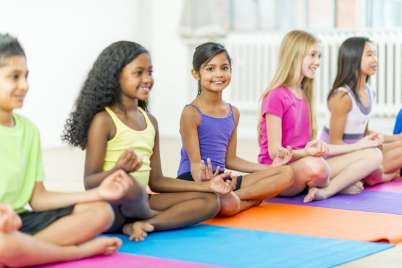
Make sure your kids have the skills to move with confidence in the water
Run, skip, hop, jump. When it comes to physical literacy, these essential skills open up a lifetime of fun and activities. But it’s about more than just mastering these movement skills, it’s about becoming proficient in these skills all year round in all sorts of environments.
Imagine the activities you can do by putting these skills to the test on the ground, in the air, or even in the snow! That’s the idea behind our new series about building physical literacy in all four environments: ground, water, ice/snow, and air. With the heat of summer still upon us, this month we’ll focus on water.
Physical literacy in and on the water
It’s about more than just being comfortable in the water, it’s about adapting the fundamental movements skills you learn on the ground for the water. Learning to swim is the first step as it builds on skills already learned on land: kicking, reaching, pulling, and even somersaulting.
Swimming is also a life skill that allows you to participate in all water activities safely. It’s the baseline from which to grow and build your confidence in water. If you know you can stay afloat, move smoothly, and jump in the water, a whole other world of possibilities open up.
Think about it. If you can: run, hop, throw, catch, jump, and swim – then you can play in the water, dive, do scuba, play water polo, kayak, canoe, sail, surf, SUP, and more! The summer gets a lot more fun once physical literacy is mastered in aquatic environments.
Getting comfortable in the water
The key to getting comfortable in the water is to start early. The sooner a child is exposed to water, be it a pool, lake, or ocean, the more likely they will develop proficiency before fear of water sets in. You can even get started in the bathtub.
As parents, you play a big role in this. According to the Canadian Red Cross, a leader in swimming education, young children should always be within arms reach of an adult when in water, and even kids who can swim need to be supervised.
You can help your child get comfortable by going in the water with them and making it fun:
- Sit on the side of a pool with them and pour water on your arms, legs and face.
- Show them how to kick and splash from the side of the pool
- Help them to walk or slip into the water safely
- Blow bubbles together
- Help them do a front and back float
If your child can do the above easily and without fear, then they are ready to take it to the next level and learn to swim. The best thing to do is to sign up for a class at your local pool. But if you are not comfortable in the water yourself, then sign them up for lessons as young as possible. Swimming lessons will teach them the skills, confidence and safety habits to become a strong swimmer.
The goal is to develop water-confident kids so they can enjoy a lifetime of water fun!
Water safety tips
According to the Canadian Lifesaving Society, drowning is the number one cause of unintentional injury deaths among children between 1 and 4 years of age, and the second leading cause of preventable death for children under 10.
Learning to swim is the best way to stay safe and prevent drownings. The society says that to survive an unexpected fall into deep water, the minimum skills you need to be able to do are:
- ROLL into deep water
- TREAD water for one minute
- SWIM 50 metres
Even if you’re not interested in water sports or activities, it’s important to know the basics of swimming if you’re ever near water or on a boat.
Bottom line: learning to swim saves lives.





